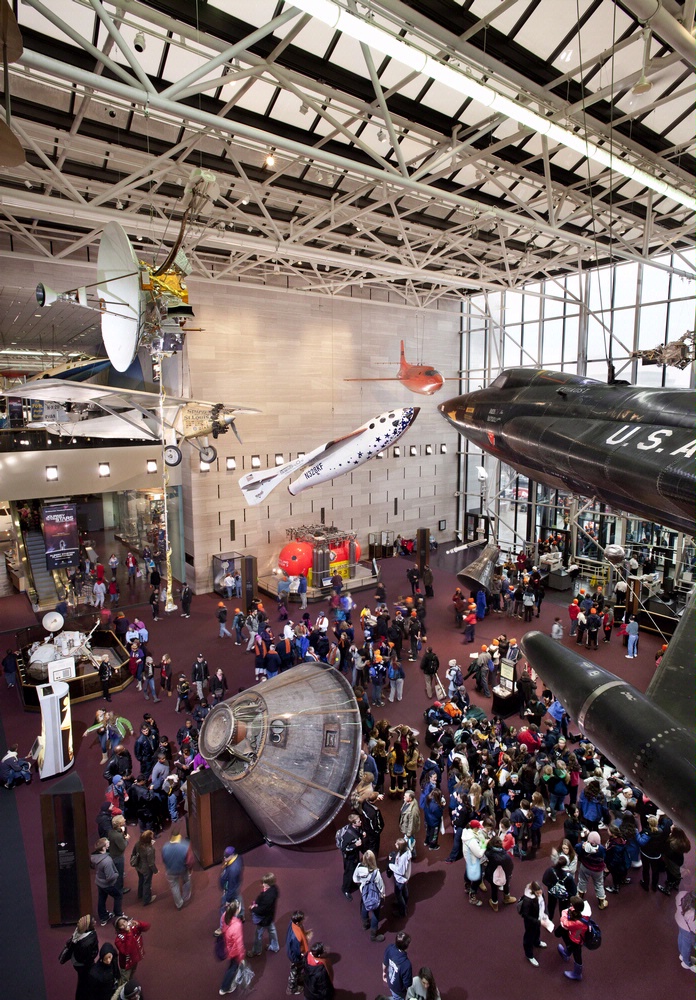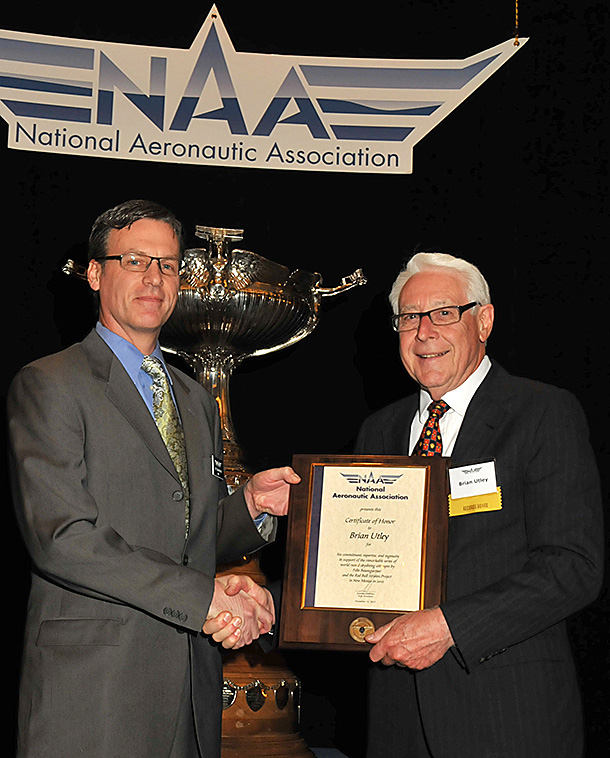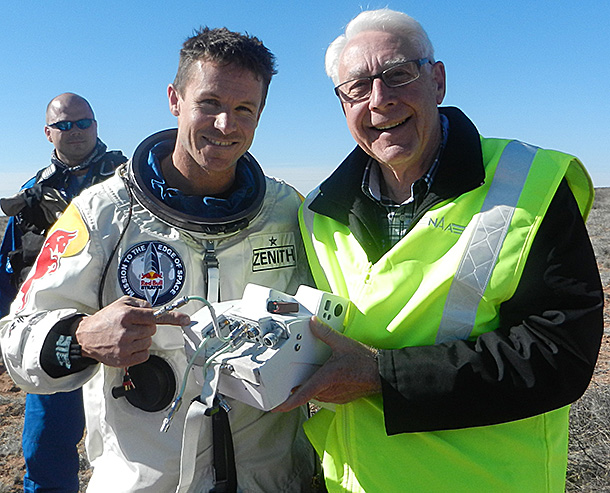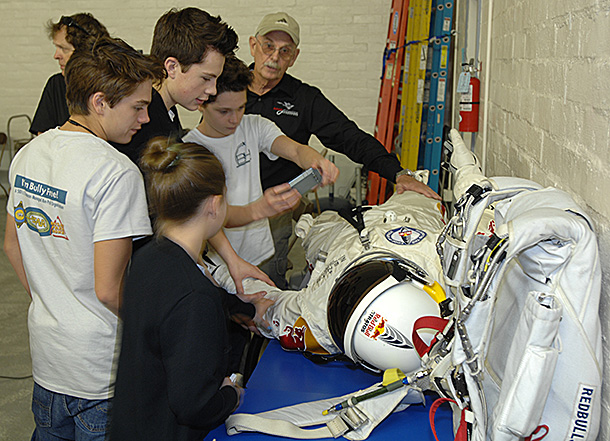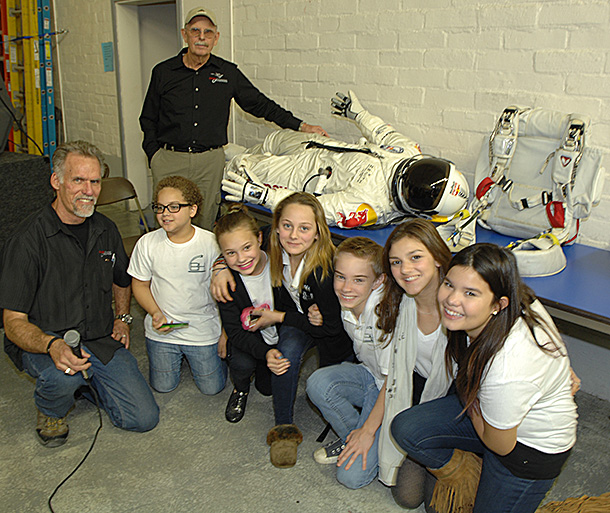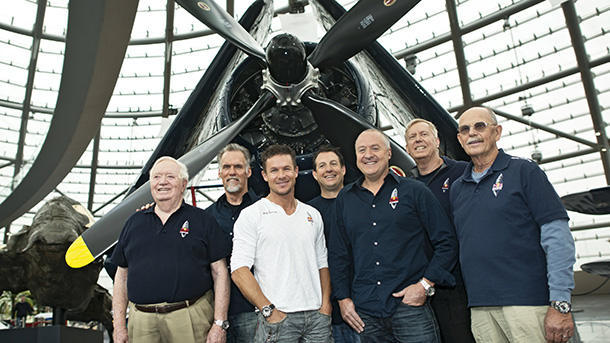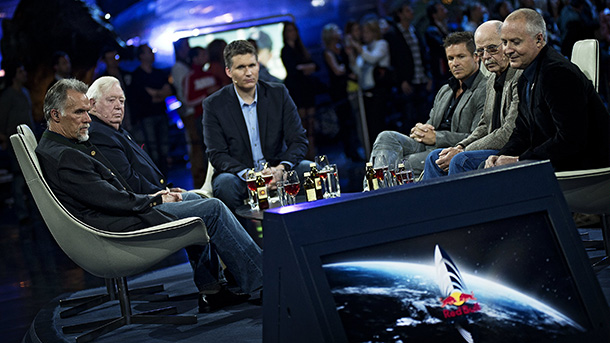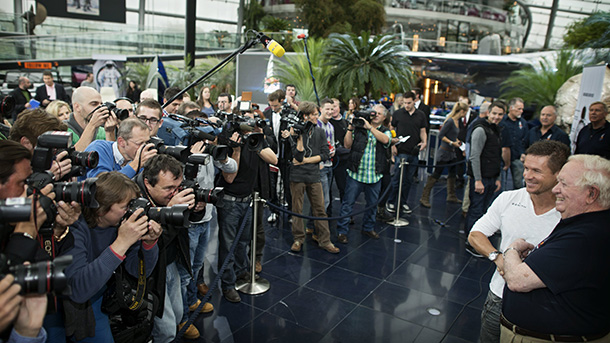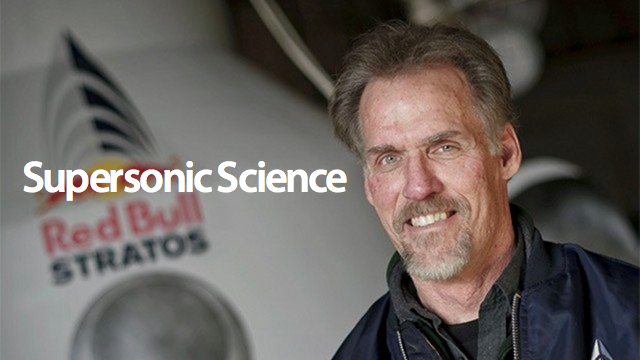By JULIE DRAKE
Valley Press Staff Writer
Antelope Valley Press, Wednesday, November 5, 2014
jdrake@avpress.com
LANCASTER – “Rock stars” for Discovery School‘s science, technology, engineering and mathematics students are people like Art Thompson, CEO of Sage Cheshire Aerospace, the Lancaster company behind the record-breaking Red Bull Stratos skydive from the edge of space.
About 230 students in Discovery’s STEM Academy, as well as some fourth- and fifth-grade students in the Gifted And Talented Education program, heard Thompson’s first-hand account of the planning and testing leading up to the moment Austrian skydiver Felix Baumgartner stepped from a capsule nearly 128,000 feet high on Oct. 14, 2012.
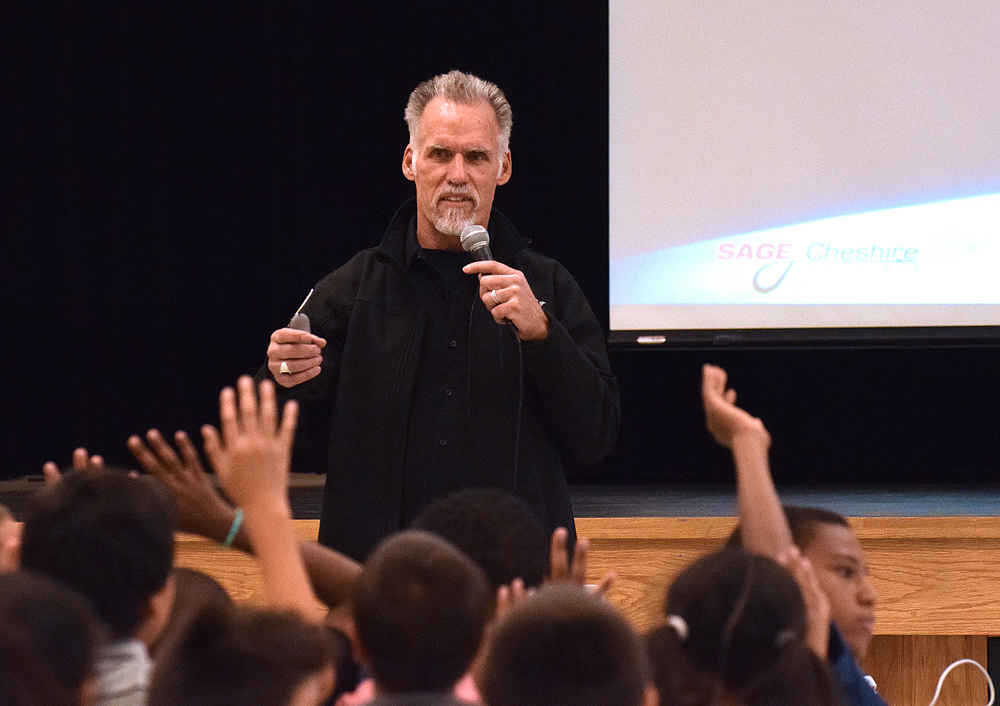 Above, Art Thompson, founder of Sage Cheshire Aerospace and designer of the capsule used by daredevil Felix Baumgartner in his record-setting jump from the stratosphere, at right, talks to Discovery School STEM Academy students Monday afternoon.
Above, Art Thompson, founder of Sage Cheshire Aerospace and designer of the capsule used by daredevil Felix Baumgartner in his record-setting jump from the stratosphere, at right, talks to Discovery School STEM Academy students Monday afternoon.RUBY ALVARADO / Valley Press
Sage Cheshire designed and built the pressurized capsule that carried Baumgartner aloft beneath a giant balloon. More than 3 billion people, nearly half of the world’s population, watched video images of the jump.
Baumgartner reached Mach 1.25, or 843.6 miles per hour, during his four-minute, 20-second supersonic free fall. The jump came 65 years to the day that pilot Chuck Yeager first broke the sound barrier in the X-1 at what is now Edwards Air Force Base. Yeager traveled at Mach 1.05 in his aircraft.
Besides building the capsule, Thompson and his Sage Cheshire firm were responsible for the modified spacesuit that protected Baumgartner during his dive.
Thompson, with Mike Todd, life support engineer for the project, showed a video of Baumgartner’s jump, with the voice of retired Air Force Col. Joe Kittinger guiding Baumgartner at the start.
Baumgartner’s jump broke an altitude record set by Kittinger in 1960 as part of an Air Force program to study and solve problems of escaping aircraft at high altitudes.
Thompson said Kittinger and test pilot Bill Weaver, who survived the midair breakup of an SR-71 Blackbird spyplane, inspired him.
The students gasped the moment Baumgartner stepped from the capsule and fell silent as he sped toward earth and a safe landing. The students applauded the film.
Thompson’s message resonated with the students.
“We all got to learn about how they built the aircraft and what inspired them … and how much work and inspiration and how much hard work and dedication that they had toward accomplishing this big event,” eighth-grader Sara Brice said.
Sara, 14, added she learned how much dedication she will need to accomplish her goals, “and to always have faith in what we want.”
The teen, who wants to be a medical engineer, said Thompson inspired her.
“He just pretty much told us to take wanting, no matter how many people say it’s impossible, you can make it possible,” she said.
Eighth-grader Jalen Gumayagay, 13, most enjoyed learning about the different mechanics that went into the capsule and the space suit.
“What I learned about this amazing event is how it was performed, all the hard work and dedication and enthusiasm that they put into this project, and how they were able to pull it off, and the results and the rewards that occurred afterwards,” Jalen said.
RUBY ALVARADO / Valley PressSixth-grader Jordan Hayen, 11, liked watching the video.
“I learned that you shouldn’t let people discourage you, that you should relentlessly pursue your goals no matter how people try to discourage you,” said Jordan, who wants to be an inventor and build weapons to stop terrorism when she gets older.
Seventh-grader Isaiah Jones, 12, said he wants to work in aeronautics when he’s older.
“I was always very interested in stuff that flies,” Isaiah said, adding that he has tried to make Lego models fly. “Basically what I learned today is never let failure put you down. If you fail, try again.”
The Red Bull Stratos program was a privately funded space program.
Thompson showed pictures from the various stages of the project’s development and talked about the math behind Baumgartner’s jump and how to ensure the daredevil’s safety.
He explained why they chose the David Clark space suit, the same kind of suit used by U-2 pilots and space shuttle astronauts, and what can happen to a person’s blood when there is not enough pressure in the atmosphere to hold gas molecules in it.
Red Bull funded the scientific research with the understanding that Sage Cheshire could then collect and share the data with NASA, the Air Force and different private space organizations to help develop emergency escape systems for future space travel, improved space suits and a better understanding of human physiology.
Thompson’s background is in aerospace research and development. His work experience includes work in developing the stealthy characteristics of the B-2 bomber with Northrop Grumman. He was able to draw on his years in this field to assemble a team of experts for the Red Bull Stratos project.
His presentation also included pictures and a brief explanation of Arturo’s Desert Eagle, the world’s largest paper airplane at 45 1/2 feet long with a 24-foot wingspan. The plane weighed 800 pounds and used 20 gallons of wood glue.
Thompson built the paper airplane while the team was still working on the Red Bull Stratos project.
“This gives you an idea. You’re students, so when you’re told no, that it’s impossible, it can’t be done, this is an example of the thinking outside of the box. Think of the crazy things that you believe you can do and try to think that it’s possible if you want to do it,” Thompson said.
Todd showed off a spacesuit worn by space shuttle astronaut Charlie Bolden and explained the difference between Bolden’s suit and the one worn by Baumgartner. He also explained the science behind Baumgartner’s suit and how it protected him.
Prior to starting Sage Cheshire, Thompson was in charge of the radar cross-section – otherwise known as the stealth team – for Northrop Grumman’s B-2 stealth bomber program. His own company has developed and manufactured specialized products for NASA, Raytheon and Boeing.
Eighth-grader Marijane Garcia said she, too, learned that she can always pursue her goals no matter how impossible they seem.
“With the paper airplane, that was pretty cool,” Marijane said. “Me, myself, wanting to become a test pilot or an astronaut, this was very inspiring.”
Fifth-grader Michael Southworth, 10, learned that failure is an option.
“It’s not something that has to come. If you don’t want to put in the effort and the dedication, then go and pick that option. But if you want to succeed, if you want to do the amazing accomplishment that they did, then you have to push through it,” Michael said, gesturing toward Thompson and Todd.

